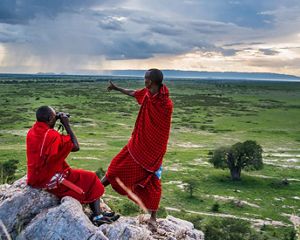Under Pressure: Study reveals extent of threats posed by industrial development to Indigenous Peoples’ lands, explores vulnerabilities to conversion
Comprehensive global assessment highlights importance of rights-based approaches to support Indigenous governance and stewardship
Media Contacts
-
Tom Jennings (U.K.)
Email: tom.jennings@tnc.org
As soaring demand for food, energy, minerals, and infrastructure pushes human activity ever deeper into Earth’s dwindling ecologically intact landscapes, a new study reveals the intense pressure this is placing on Indigenous Peoples and their lands – and underscores the need to accelerate collaborative actions and rights-based approaches to relieve these tensions.
Led by scientists from global conservation non-profit The Nature Conservancy (TNC), the study – published in the journal One Earth – harnesses global data and spatial mapping to show that almost 60% of Indigenous Peoples’ lands (equivalent to 22.7 million km2), across 64 countries and all inhabited continents, are threatened by industrial development. Areas of West and Central Africa were found to be facing the highest risk of conversion, given underlying socio-economic and political vulnerabilities.
Despite comprising 6.2% of the global population, Indigenous Peoples formally or customarily govern at least one-quarter of the world’s terrestrial surface. Due to their stewardship, the vast majority (~92% or 35.4 million km2) of Indigenous Peoples’ lands remain in good to moderate condition, accounting for 39% of Earth’s most ecologically intact lands. As governments strive to tackle interconnected crises of climate change and nature loss, partnering with Indigenous Peoples – the original and best stewards of these ecologically and culturally important lands – has never been more important.
The study – conducted alongside Charles Darwin University, Universitat Autònoma de Barcelona, Manchester Metropolitan University, and TRAFFIC – found that drivers of industrial development pressure on Indigenous Peoples’ lands include energy infrastructure, commercial agriculture for crops and biofuels, mining, and urbanisation. Development pressures from these different sectors vary by region, as do the potential risks they pose.
Christina Kennedy, co-lead author and director of spatial conservation science at TNC, comments: “We mapped the spatial extent and pattern of conversion threat to Indigenous lands to better understand the magnitude of this issue globally, as well as to help identify places where strategic actions and investments might be needed to support Indigenous governance and stewardship. We also created a global index to explore how socio-economic and political contexts might influence conversion vulnerability and risk across different nations.”
In order to assess conversion vulnerability and risk to Indigenous Peoples’ lands—and help identify opportunities to mitigate this risk—the TNC-led study developed a new ‘Rights-Representation-Capital Index.’ The index measures the strength and security of Indigenous People’s rights to their territories and resources; their levels of representation and engagement in decisions that impact them; and their access to the various forms of capital available to support conservation and sustainable development.
Elaborating on this work, Brandie Fariss, co-lead author and conservation social scientist at TNC, said: “Actions that foster Indigenous Peoples’ self-determination, and center their rights and leadership will be central to our efforts to address biodiversity loss and climate change. Related to the findings of this paper, I’m encouraged that there are a growing number of successful examples of equitable, inclusive, and Indigenous-led approaches to conservation, from which to draw guidance, insights and further support.”
Recognizing and upholding the rights and territories of Indigenous Peoples and local communities is seen as central to efforts to secure lasting protection for at least 30% of Earth’s lands, inland waters, coasts, and oceans by 2030; and as such, is enshrined within the UN Kunming-Montreal Global Biodiversity Framework agreed in Canada last December.
Read more about TNC’s 2030 Goals and our Voice, Choice, and Action (VCA) Framework, which guides our work with Indigenous Peoples and local communities.
# # #
Notes for Editors
Kennedy C.M., Fariss B., Oakleaf J.R., Garnett S.T., Fernández-Llamazares A., Fa J.E., Baruch-Mordo S., Kiesecker J. Over half of Indigenous Peoples’ lands are threatened by industrial development, global conversion risk assessment reveals need for greater support of Indigenous stewardship. One Earth.
The Nature Conservancy is a global conservation organization dedicated to conserving the lands and waters on which all life depends. Guided by science, we create innovative, on-the-ground solutions to our world’s toughest challenges so that nature and people can thrive together. We are tackling climate change, conserving lands, waters and oceans at an unprecedented scale, providing food and water sustainably and helping make cities more resilient. The Nature Conservancy is working to make a lasting difference around the world in 81 countries and territories (40 by direct conservation impact and 41 through partners) through a collaborative approach that engages local communities, governments, the private sector, and other partners. To learn more, visit nature.org or follow @nature_press on X.



